Excerpts from Jim Conrad's
Naturalist Newsletter
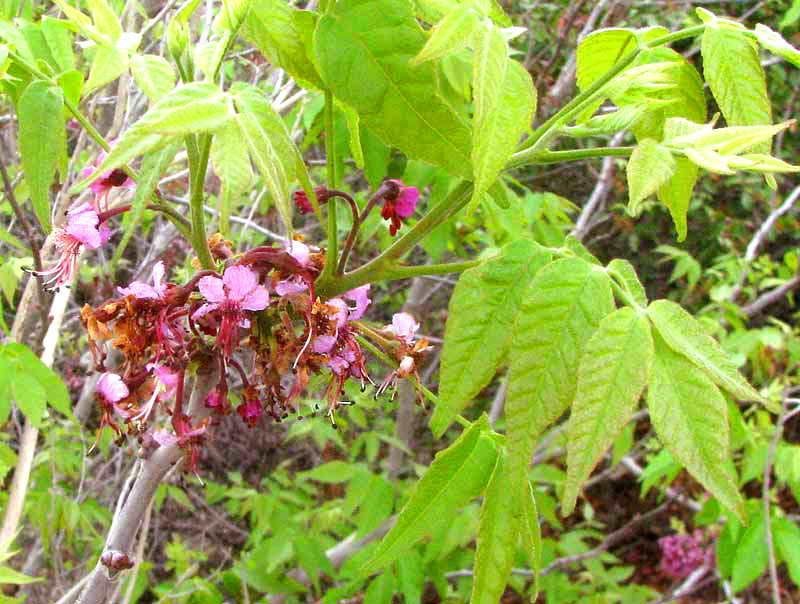
from the April 7, 2013 Newsletter issued from the Frio Canyon Nature Education Center in northern Uvalde County, southwestern Texas, on the southern border of the Edwards Plateau; elevation ~1750m (~5750 ft); N29.62°, W99.86°; USA
MEXICAN BUCKEYES FLOWERING
On ravine slopes and just below limestone ledges adjacent to the Frio River in northern Uvalde County at first glance the small trees opulently abloom with pink blossoms seemed to be eastern North America's Redbud trees, or maybe escaped peach trees, but up close it was clear that they were something else, as shown above.
The tree's leaves were alternate (one leaf per stem node) and pinnately compound, looking a lot like hickory or walnut leaves. However, the asymmetrical flowers with five pink petals and a mess of hard-to-interpret anatomy in their center were completely different from any hickory or walnut flower, as you can see in the blossom close-up below:
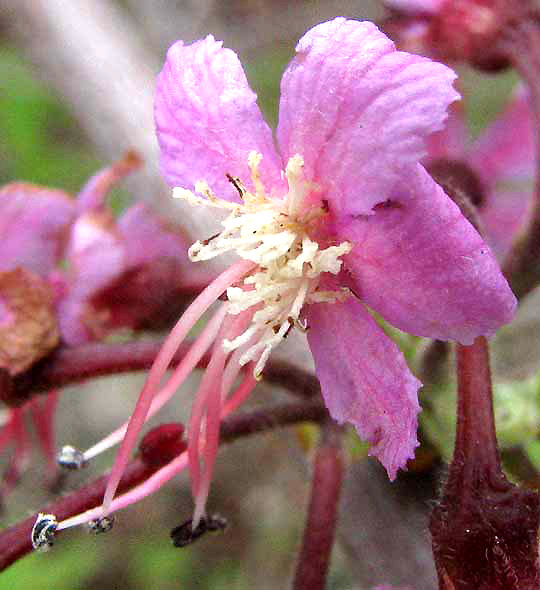
As I photographed the very unusual, inch-broad (2.5cm) blossoms, Fred pointed out some old fruit pods still hanging on some of the trees' outer branches, such as the ones shown below:
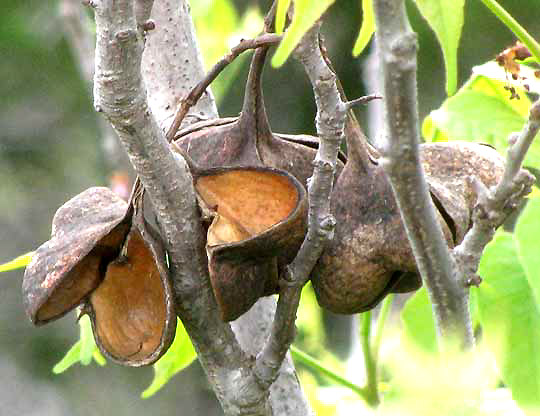
These capsular-type fruits have split to release one large seed from each of three large compartments.
In most of North America there's simply nothing like this. Fruiting capsules with three compartments and asymmetrical or "zygomorphic" flowers immediately bring to mind the Euphorbia Family, but when I checked out all the species in that family found in Texas, there was nothing like it.
Eventually, though, the little trees gave up their identities. They were Mexican Buckeyes, UNGNADIA SPECIOSA, members of the Soapberry Family, the Sapindaceae, a family mostly restricted to the tropics and subtropics. Soapberry Family species North American plant lovers might know include the Goldenrain-Tree, Litchi Tree, and the Heart-Seed Vine, Cardiospermum. Mexican Buckeyes occur very spottily throughout southern Texas, extreme southern New Mexico, and arid northeastern Mexico. Though Mexican Buckeyes belong to a different genus than North America's buckeye species, both are members of the same family. You might note, however, that the North's buckeyes bear opposite, digitately compound leaves, while Mexican Buckeyes have alternate, pinnately (featherlike) compound leaves.
In our flower picture it's easy to recognize the five rose-purple petals, as well as the eight or nine well formed stamens with their dark, baglike anthers splitting open and releasing pale pollen grains, atop long, slender, curving, pinkish filaments. One curious thing about the stamens is that their number of eight or nine per blossom is unusual -- "normal" flowers bear 3, 4, or 5 or multiples thereof -- plus their filaments are of varying lengths. Moreover, some of the whitish items clustering about the stamens' bases look like ill-formed, undeveloped stamens, some with dark anthers not producing pollen. In fact that's what the white things are -- sterile, undeveloped stamens, and that's natural for Ungnadia. Maybe they provide a foothold for pollinators.
Mexican Buckeyes are such unusual plants that they are the only species in their genus.
In the past, Mexican Buckeye's sweetish but poisonous seeds were sometimes used by children as marbles. Livestock usually know better than to browse the tree's toxic foliage. Bees produce fragrant honey from the flowers.
In northeastern Mexico in caves occupied by people as far back as 8000 years, remnants of Mexican Buckeye have been found associated with hallucinogenic Peyote and Mescalbean remains, so it's assumed that the species' toxic seeds were used in certain rituals.
The small tree's genus name, Ungnadia, commemorates Baron Ferdinand von Ungnad, Austrian ambassador at Constantinople, who introduced the related Horsechestnut into western Europe in 1576.
from the August 18, 2013 Newsletter issued from the Frio Canyon Nature Education Center in the valley of the Dry Frio River in northern Uvalde County, southwestern Texas, on the southern border of the Edwards Plateau; elevation ~1750m (~5750 ft); N29.62°, W99.86°; USA
MEXICAN BUCKEYES DROPPING
This April we never got to see the Mexican Buckyeye's seeds, known as buckeyes. Now our Mexican Buckeyes' capsular fruits are ripe and splitting open, as shown below:
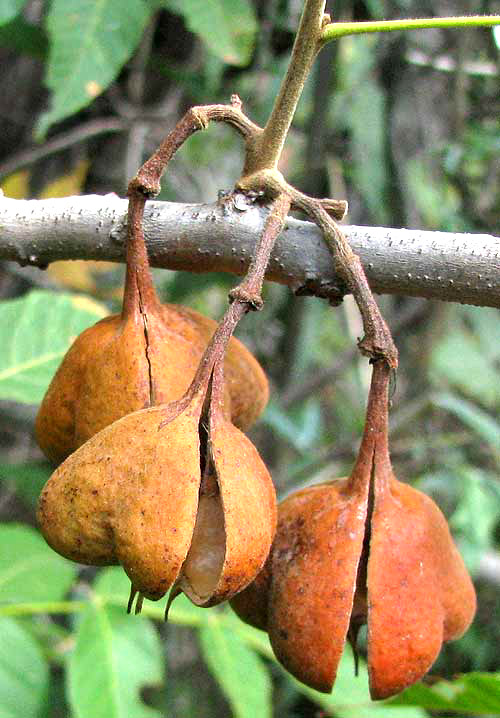
An opened pod with a buckeye seed staring at us appears below:
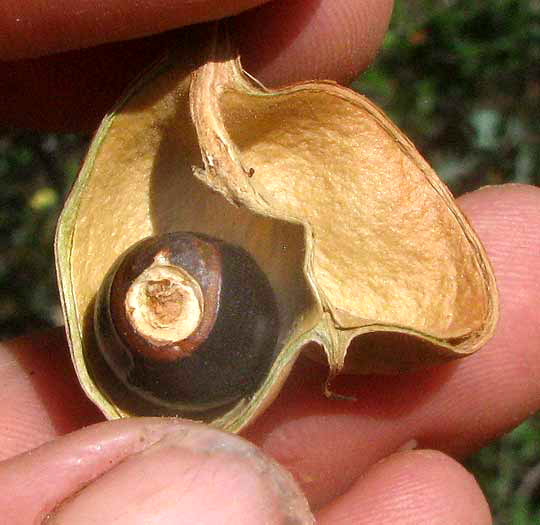
Seeing the seed's roundness, it's easy to believe old reports of kids using them as marbles.
If you're familiar with Ohio Buckeyes, which also occur here, you can see that the Mexican Buckeye's leathery capsule is shaped differently (not spherical), and that the seed is much smaller. The seed in the picture is 7/16ths inch broad (11mm). The pale tan spot on the blackish seed is the scar left from the umbilical-like "funiculus" connecting the seed to the capsule, and is referred to as the hilum. Buckeye seeds display unusually large, conspicuous hila.
Though the seeds on the ground are eaten by insects and certain small mammals, they're known to contain the toxic alkaloid saponin. Still, Geoffrey Stanford reported in a 1981 issue of "Plant Propagator" {28(2): 5-6} that he and his colleagues ate up to twenty seeds, finding them tasting like pistachio nuts, and suffered no ill effects. However, Stanford followed up by feeding Mexican buckeye seeds to rats, who consequently exhibited signs of both neurological and organ damage, most of them dying within three weeks. Once the rats died, Stanford ended his seed-eating experiment.